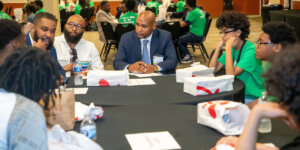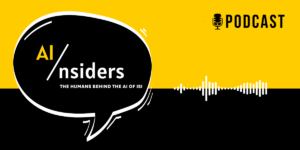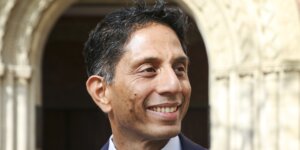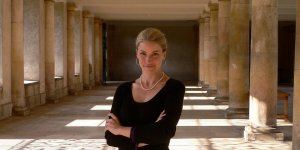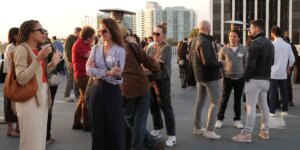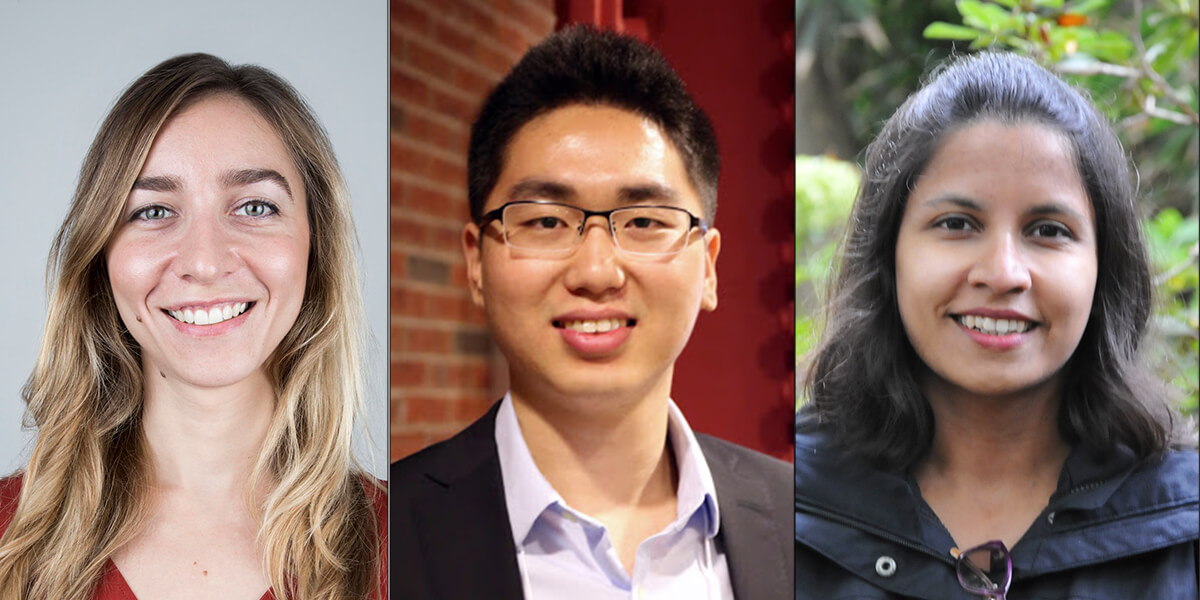
Even in the face of remote learning, Professor Vayanos, Professor Ren, and Professor Sharada have taken the opportunity to make an impact on high schoolers through various outreach projects and programs. (Images Courtesy of Vayanos, Ren, and Sharada)
It’s been over a year since the COVID-19 pandemic changed how we live, how we communicate, and how we learn.
In the case of the USC Viterbi School of Engineering, professors have taken the limitations of online learning and turned them into positives by engaging in projects with high schoolers both in the community and beyond.
“Remote learning can make it really hard for teachers to engage their students,” said Katie Mills, the co-director of USC Viterbi’s K-12 STEM Center. “We had to adapt, and it was so great to see these Viterbi professors actually take advantage of these circumstances. They were able to reach out to and work pretty closely with these high school students. Their deep level of engagement may not have been possible if schools weren’t online.”
Artificial Intelligence for Social Good
Phebe Vayanos, a WiSE Gabilan assistant professor of industrial and systems engineering and computer science and the associate director of the USC CAIS Center for Artificial Intelligence in Society, worked to develop a live, virtual workshop event, called ExplOR, where high school students learned about the real-world applications of artificial intelligence.
The workshop, which took place Nov. 7, connected students with professors, researchers, and Ph.D. students from across the country. Vayanos organized the workshop jointly with USC Viterbi students Aida Rahmattalabi, a Ph.D. student studying computer science, and Caroline Johnston, a Ph.D. student studying industrial and systems engineering.
“The goal of ExplOR was to familiarize students, specifically those from underserved communities, with operations research and artificial intelligence and their applications to social good,” Rahmattalabi said. “We wanted to achieve this by having the students get hands-on experience in solving different, real-world problems that can benefit from artificial intelligence or operations research solutions.”
The event was funded by the INFORMS Diversity, Equity, and Inclusion Ambassador Initiative, which provides grants to support projects that improve diversity, equity, and inclusion in areas including workplace practices, teaching, and research. Rahmattalabi, Johnston, and Vayanos received the INFORMS DEI Program Award in 2020 for their proposal “Bringing STEM Education to Underserved Communities.”
During the workshop, students were divided into smaller groups with an assigned mentor. Vayanos served as one of the mentors during the event, and other mentors included faculty and students from the Georgia Institute of Technology, Northeastern University, and Harvard University. Many of the attending students were a part of Code in the Schools, a Baltimore-based nonprofit organization that works to expand access to computer science education to youth in the area. High school students from the STEM Academy of Hollywood in Los Angeles also attended the event.
Each group of students was assigned to a real-world issue, with examples including problems related to wildlife conservation, homelessness, and urban planning. Student groups worked with their mentor to draft a solution to the problem using concepts that were taught earlier in the workshop, which included topics like game theory, optimization, and simulation. The event concluded with a final presentation where students shared their approaches to their assigned problem.
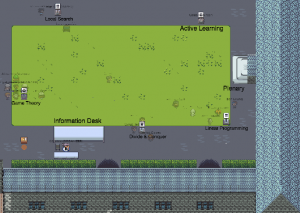
The ExplOR event took place in Gather.town, a web conferencing software that allows participants to move an avatar through a virtual world and interact with others.
The event occurred live through a software called Gather.town, an online video game-esque environment where users control a virtual avatar and can interact with others in real-time in a fun and easy way.
“Gather.town includes a map, which we designed according to our needs for the event,” Rahmattalabi said. “For example, on the map, we set up different rooms for the groups to have discussions with a virtual whiteboard and Google Slides presentation for brainstorming. We also had a room where all the attendees gathered for the final presentations.”
According to student feedback from a post-event survey, ExplOR was a success. All of the students reported that they are “more interested in one or more specific fields of engineering and/or computer science, such as operations research or artificial intelligence.”
“During the workshop, students not only learned technical and mathematical concepts, but they also learned about their applications to real-world problems,” Vayanos said. “We hoped that this would be valuable in facilitating the students’ understanding of these topics, but also in incentivizing students to pursue these relevant fields by seeing the potential for real, social impact.”
Although the workshop was a single, one-day event, Vayanos, Rahmattalabi, and Johnston hope to continue to host similar ones in the future.
“Repeated exposure to how powerful (and cool!) AI and OR can be is super important in getting high schoolers to think that this is something they might want to learn more about in college,” Johnston said. “In a one-day workshop, of course, we couldn’t teach these students everything, but if there is enough to spark the “I want to learn more about this”, then I believe our event and our future endeavors are a success!”
Building Chemical Understanding through Computer Software
Shaama Sharada, a WISE Gabilan Assistant Professor of chemical engineering and materials science and chemistry at USC Viterbi, is helping high schoolers better understand chemistry by introducing them to a free software program known as IQmol. The software, which models the three-dimensional structure of molecules, is helping students at Hawthorne Math and Science Academy to better understand climate change.
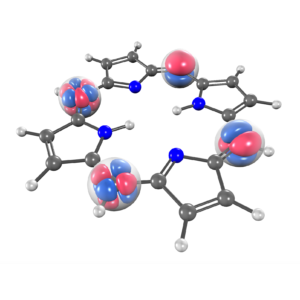
This IQmol-generated image is an example of the capabilities of the free software, which allows users to visualize molecules, bonds, orbitals, and other properties of molecules and chemical compounds. (Image Credit: IQmol Website Gallery)
Sharada, who uses IQmol daily in her own research, felt that the software would be beneficial for high school students. She remembered back to her own education, when she often felt the visual component of chemistry was missing from her learning.
“High schoolers learning chemistry are used to seeing molecules two-dimensionally on paper or on a whiteboard, which can make the subject difficult to grasp and understand,” Sharada said. IQmol maps out the actual structure of these molecules, so students can visualize where atoms and electrons are located and better understand how they interact.”
Initially, Sharada reached out to the USC Viterbi K-12 STEM Center in the fall of 2019 to talk about how she could bring this program to high schools in the area. Mills helped her connect with Meredith Brandon, the environmental science teacher at the Hawthorne Math and Science Academy, who was interested in integrating this program into her curriculum.
“IQmol has a really simple interface and it’s pretty intuitive,” Sharada said. “High schoolers today are generally pretty technologically adept, so I really felt like this software would be easy for them to use and make a huge difference in their chemical understanding.”
In January 2020, Sharada gave a presentation about IQmol in Brandon’s environmental science classes. During the presentation, Sharada talked about how her own research group uses the software to study chemical reactions by visualizing the interactions between electrons and atoms. She then gave a tutorial and following this demonstration, students were encouraged to play around with the software. At the end of the session, students created their own models of greenhouse gases like methane and carbon dioxide.
“In a normal school year, I would have my students building 3-D models of different molecules in class, but when we are learning virtually it’s hard to do any hands-on modeling,” Brandon said. “IQmol has been a great tool to get students building and manipulating models on the computer.”
Over the summer of 2020, Brandon worked with Kareesa Kron, a Ph.D. student in chemical engineering studying under Sharada, to create content for a lesson plan designed to teach students more about greenhouse gases using the IQmol software.
“Modeling greenhouse gases can help us understand the fundamental chemical properties that explain global warming processes,” Kron said. “This lesson plan facilitates this understanding by giving students a hands-on opportunity to look at the molecular properties of different gases.”
The lesson plan, which includes activities and exercises for students, along with answer keys and additional materials for teachers, is available for free online on the Women in Chemical Engineering webpage. Kron, who serves as the outreach coordinator for WChE, and Sharada, the faculty advisor of the group, hope to continue to build out new lesson plans that teachers and students can use.
“The capabilities of IQmol go way beyond just visualizing greenhouse gases. The software could also give students a three-dimensional representation of amino acids, proteins, sugars, enzymes, and more,” Sharada said. “In the future, I would love to expand beyond just environmental science classes and help to integrate IQmol into other high school science classes, like chemistry and biology.”
Artificial Intelligence for Detecting Online Hate Speech
Xiang Ren, a USC Viterbi assistant professor of computer science, worked to teach high school students about the applications of artificial intelligence, with a focus on detecting and moderating online hate speech.
“Artificial intelligence has many, many exciting applications in the real world,” Ren said. “Technology is changing and advancing very quickly, and I want students to be excited about the possible careers they can pursue in these fields.”
This past December, Ren gave presentations to students at two local high schools: Roosevelt High School and the STEM Academy of Hollywood. During the presentation, he talked about how artificial intelligence and machine learning algorithms can be used to detect hate speech on online platforms like Facebook. He also spoke on his own research in natural language processing and the key role this topic plays in speech recognition and language analysis technology like Siri.
“I think students found Professor Ren’s presentation to be really valuable and interesting,” said Sarah Thomas, an assistant director in the K-12 STEM Center who worked to coordinate the project by facilitating and organizing communication between Ren and staff at the high schools. “They asked a lot of questions and were really engaged.”
Computer science teachers, Ed Kim from Roosevelt High School and Jennifer Stone from the STEM Academy of Hollywood, were inspired to further pursue the lessons from Ren’s workshop. They each worked to develop a project for their students based on the applications of artificial intelligence for social good.
Students at Roosevelt High School, for instance, were assigned to create bots and design code with the ability to detect hateful or discriminatory language in the chat feature of a fictional software company. USC students from the National Society of Black Engineers volunteered with these high schoolers to serve as mentors and help them write their code. Students presented their final projects in March.
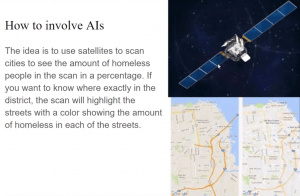
A group of Ph.D students from Professor Ren’s lab provided feedback to STEM Academy of Hollywood students on their project proposal on providing support for the homeless using AI.
By contrast, students at the STEM Academy of Hollywood were assigned a broader project. They were given the opportunity to choose a real-world problem with a potential AI-based solution. One student proposed using AI to monitor the movement of animals around urban areas to keep them safe. Another student suggested using AI for optimizing resource allocation and distribution to homeless individuals and families. In early March, students met with Ren and a group of USC Viterbi computer science Ph.D. students, who listened to their ideas and provided feedback.
“Seeing how engaged and interested my students were during Professor Ren’s presentation was really rewarding,” Stone said. “When he spoke about hate speech and social media, I think many of them connected on a personal level, and they’ve been really excited and outspoken throughout the project that followed.”
The USC Viterbi K-12 STEM Center is committed to providing opportunities for youth, family, and schools through programs aimed to build knowledge, skills, self-efficacy, and leadership. To connect and learn more, visit https://viterbik12.usc.edu or send an email to k12stem@usc.edu.
Published on June 10th, 2021
Last updated on April 24th, 2025




